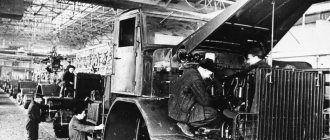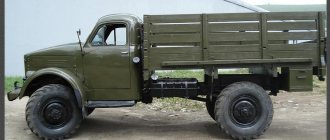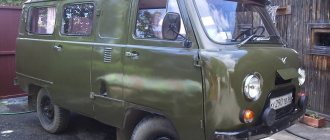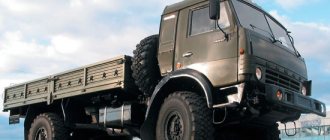BAZ-5921
Total information
| Manufacturer: | Bryansk Automobile Plant |
Design
| Wheel formula: | 6 × 6 |
Engines
5D20K-300
| Manufacturer: | Barnaul Transport Engineering Plant |
| Brand: | 5D20K-300 |
| Type: | diesel |
| Maximum power: | 300 l. With. |
| Cylinders: | 6 |
| Cooling: | liquid |
Other
| Load capacity: | 7200 kg |
K:Wikipedia:Articles without images (type: not specified)
BAZ-5921
- a special three-axle floating chassis of the Bryansk Automobile Plant, used as part of the 9K79 Tochka high-precision tactical missile system. Developed on the basis of the BAZ-5937 9K33 “Osa” chassis family, from which many units were borrowed[1], but the supporting body and layout had to be designed almost anew due to the need to provide a tactical missile with an almost vertical launch - unlike an air defense missile system combat vehicle, where the antenna-launching device was located in the middle of the vehicle and the engine at the rear, in the SPU fuel dispenser the power plant is located in the front part of the cargo compartment (closer to the control compartment), and the launcher is in the rear [2].
Excerpt characterizing BAZ-5921
– Which committee was the note sent to? - asked Prince Andrei. - To the committee on military regulations, and I submitted a proposal to enroll your honor as a member. Just no salary. Prince Andrei smiled. - I don’t want to. “Without a salary as a member,” Arakcheev repeated. - I have the honor. Hey, call me! Who else? - he shouted, bowing to Prince Andrei. While awaiting notification of his enrollment as a member of the committee, Prince Andrei renewed old acquaintances, especially with those persons who, he knew, were in force and could be needed by him. He now experienced in St. Petersburg a feeling similar to what he had experienced on the eve of the battle, when he was tormented by a restless curiosity and irresistibly drawn to higher spheres, to where the future was being prepared, on which the fate of millions depended. He felt from the embitterment of the old people, from the curiosity of the uninitiated, from the restraint of the initiated, from the haste and concern of everyone, from the countless number of committees, commissions, the existence of which he learned again every day, that now, in 1809, was being prepared here in St. Petersburg, some kind of huge civil battle, the commander-in-chief of which was a person unknown to him, mysterious and who seemed to him a genius - Speransky. And the most vaguely known matter of transformation, and Speransky, the main figure, began to interest him so passionately that the matter of military regulations very soon began to pass into a secondary place in his mind. Prince Andrei was in one of the most favorable positions to be well received into all the most diverse and highest circles of the then St. Petersburg society. The party of reformers cordially received and lured him, firstly because he had a reputation for intelligence and great reading, and secondly because by his release of the peasants he had already made himself a reputation as a liberal. The party of dissatisfied old men, just like their father’s son, turned to him for sympathy, condemning the reforms. Women's society, society, welcomed him cordially, because he was a groom, rich and noble, and almost a new face with the aura of a romantic story about his imaginary death and the tragic death of his wife. In addition, the general voice about him from everyone who knew him before was that he had changed a lot for the better in these five years, had softened and matured, that there was no former pretense, pride and mockery in him, and there was that calmness that purchased over the years. They started talking about him, they were interested in him and everyone wanted to see him. The next day after visiting Count Arakcheev, Prince Andrei visited Count Kochubey in the evening. He told the count his meeting with Sila Andreich (Kochubey called Arakcheev that way with the same vague mockery that Prince Andrei noticed in the reception room of the Minister of War).
CAR REPAIR
This vehicle is very often confused with the hull floating wheeled chassis of the Osa BAZ-59E7 anti-aircraft missile system and, what is especially offensive, even authoritative encyclopedic publications on domestic automotive technology and multi-volume studies reflecting the history of the development of the Russian-Soviet automotive industry are guilty of this. In the few magazine publications about military vehicles, as a rule, only a brief description with very approximate values of the parameters of the special wheeled chassis BAZ-5921 (BAZ-5922) is given, where the main difference between the vehicles is considered to be a slightly modified body shape and a front-mounted engine. Only a person very far from technology can agree with this - after all, moving the power unit to the opposite part of the car is not at all the same as moving a cabinet to another room. And if we experimentally try to install the engine in the front trunk of a Zaporozhets or make the classic Zhiguli rear-engine, then we are unlikely to get by with minor changes to the body. In our case, we are talking about a complex military vehicle with strictly specified weight load indicators, overall and layout characteristics, and strict conditions for the placement of weapons and crew. Therefore, it is hardly acceptable to talk about the BAZ-5921 as a modification of the BAZ-5937, even if they are very similar in appearance. Of course, due to the close mass-dimensional parameters, power supply, mobility, cross-country ability, maneuverability, as well as the optimal combination of components and assemblies already mastered in mass production, there is a certain unification with the BAZ-5937 floating chassis and its modifications, as well as with other Bryansky vehicles plant And the design of both machines was carried out by the same design team, taking into account production conditions, existing technologies using well-developed technical solutions tested under harsh operating conditions. Therefore, the wheeled chassis BAZ-5921 and BAZ-5922 are an independent family of wheeled combat vehicles that have specific characteristics for placing certain types of weapons on their base. The errors that occur in identifying models can partly be explained by the secrecy regime that existed for many years. In Soviet times, it was customary in the media to refer to the three-axle floating chassis of the BAZ as “all-wheel drive vehicles with a 6x6 wheel arrangement and a uniform arrangement of axles along the base” without mentioning any digital indices, although these vehicles did not represent a special secret for the “adversary”. In well-known foreign directories one could see the complete tactical and technical data of the chassis, their designations and photographs, as well as information about the manufacturer (although in these directories, for obvious reasons, there were errors). Today, many of the vehicles we are interested in serve in the armies of near and far abroad, work in civilian organizations and are even in private use, so it is possible to get acquainted with their design features. By the end of the 60s of the last century, there was a need to create a new divisional tactical missile system, designed to replace the Luna complex, widespread in the ground forces, and its modernized version, Luna-M. The main developer of the complex (product 9K79), called “Tochka”, was determined to be the Mechanical Engineering Design Bureau (KBM, Kolomna, Moscow Region) headed by chief designer S.P. Invincible. O.M. was appointed lead designer for the complex as a whole, as well as for the self-propelled launcher and transport-loading vehicle. Toloshchuk. The development of the transport vehicle was entrusted to the design bureau led by E.M. Shlakhter. The design of technological equipment was carried out under the leadership of G. G. Nalivaiko. The tactical and technical specifications for the development of the Tochka missile system provided for the following characteristic features: high mobility (thanks to the use of special wheeled chassis with developed cross-country ability) and maneuverability of the complex in difficult road conditions on the ground; the ability to overcome water obstacles afloat; transportation of combat and auxiliary vehicles of the complex with a full ammunition load of missiles by all types of transport (sea, railway with size 02-VM and aviation - aircraft such as AN-126 and IL-86); full autonomy of performing a combat mission with one launcher, including calculation of a flight mission when specifying target coordinates without the additional involvement of other means; the possibility of combat use in various natural and climatic zones in a wide range of temperatures without carrying out topographic and geodetic and engineering preparation of the launch position; secrecy of missile preparation at the launch site until the very moment of launch; a short period of time for preparing and launching a rocket; high firing accuracy with the ability to ensure launch in a sector ±15° from the main direction without additional maneuvering of the self-propelled launcher. As we can see, along with the creation of a high-precision missile and advanced launch equipment, a prominent place was given to the development of a promising all-terrain chassis for installing weapons. The rocketeers, unlike the creators of mobile air defense systems, did not spend a long time looking for the developer of the machine, but immediately paid attention to the young talented design team - SKB (OGK) of the Bryansk Automobile Plant, which was headed at that time by Ivan Lyudvigovich Yurin. Technical requirements were developed for the creation of a chassis for the launcher and transport-loading vehicle. In accordance with the Resolution of the Central Committee of the CPSU and the Council of Ministers of the USSR, in 1968, BAZ began designing new army vehicles for the Tochka complex. The choice in favor of SKB BAZ was not made by chance. Firstly, wheeled chassis BAZ-1E5LM and BAZ-1E5LTM for the Luna tactical complex were already produced in Bryansk, secondly, there were close ties with BAZ designers for technical support of manufactured products and, thirdly, there was successful experience in military operation three-axle wheeled chassis as part of the Osa air defense system. According to the conditions for placing the missile and special launch equipment, it was necessary to move the cargo compartment to the rear part of the hull, since the launch of an operational-tactical missile is carried out from a position close to vertical. To do this, it was necessary to rearrange the BAZ-5937 chassis taken as a basis: to accommodate a crew of four people; install the transmission and control drives; coordinate the operation of the steering, braking system, electrical equipment, hydraulic drives, water-jet propulsors and their drives; provide the required dimensions of the cargo compartment with mounting locations for the launcher, camouflage means, ventilation, heating and additional equipment. The task turned out to be very difficult and the original plan to adapt the Osa chassis for the self-propelled launcher of the Tochka complex was abandoned. The supporting body of the machine was redesigned, and with it the layout of components and assemblies. The completely new all-metal welded body of the BAZ-5921 chassis with a built-in frame was divided by a sealed partition into a control compartment (Fig. 5) in the bow and a cargo compartment. In the roof of the control compartment there were two hatches for the entry and exit of the crew, three windows on the wind frame (the right wind window can be opened) and two windows on the sides. Behind the control compartment there was a cargo compartment designed to accommodate power plant units, transmission, additional equipment and a launcher. The cargo compartment is closed with a folding roof, which is controlled from the control compartment. A trunk is welded into its rear part to accommodate a set of spare parts. The power plant was a six-cylinder U-shaped Barnaulsky diesel engine with a cylinder angle of 120°, model 5D20K-300 (a modification of the 5D20B-300 diesel engine installed on the BAZ-5937). For layout reasons, the power unit with clutch and gearbox was rotated 180° with the crankshaft toe forward. The engine differed from the 5D20B-300 in the presence of two oil radiators in the lubrication system, a modified cooling system with two radiators located to the right and left of the engine on the sides of the chassis and two ejectors, the housings of which were integral with the chassis body and were welded into the sides of the vehicle. Exhaust gases were diverted upward from two side ejectors, while in the BAZ-5937 the ejector ejected exhaust gases backwards. The power system had two fuel tanks: the main one, with a capacity of 350 liters, and a supply tank with a fuel injection pump built into it. The air supply and preheating systems were changed, as well as the pipelines of the cooling, lubrication, and fuel supply systems. The diesel engine had a power of 300 hp. and was started by air (main starting system) or electric starter (backup). The transmission, like most BAZ vehicles, was made according to the principle of on-board power distribution and consisted of a double-disc clutch with a hydraulic control drive and a pneumatic booster, a mechanical five-speed three-way gearbox, a two-speed five-shaft transfer case with a lockable side differential. The gearbox is controlled remotely using a mechanical rocker. The transfer case was controlled by a pneumatic drive with a system of valves, pneumatic chambers and pipelines. The transmission also included six final drives to transmit torque to the drive wheels at an angle of 90° and six single-stage wheel reduction gears to increase torque and create the necessary ground clearance. Final drives and wheel gearboxes were unified with similar chassis components of the Osa air defense missile system and other BAZ products. The gearbox and transfer case were distinguished by control drives and a power take-off mechanism for the water jet drive, which on the BAZ-5921 chassis is carried out from the gearbox through the transfer case and the central gearbox of the water jets. The number of cardan shafts in the BAZ-5921 transmission, compared to the BAZ-5937, was also increased from 16 to 18 pieces. The chassis of the vehicle, wheels with wide-profile tires and an air pressure regulation system were not structurally different from the chassis of the Osa air defense system. In the lower aft part of the hull, water-jet propulsors were mounted, consisting of two water jets, a central gearbox and cardan shafts. The water jets were controlled using two dampers located at the outlet pipes. The steering with front and rear steered wheels consisted of a steering mechanism, a drive to the steered wheels and a hydraulic power steering system with two hydraulic boosters. The braking system is pneumohydraulic with sealed shoe-type wheel brakes and a hand-operated parking brake acting on the final drives of the front wheels. The 24V electrical equipment system was carried out using a single-wire circuit in a shielded design. The chassis hydraulic system, combined with the power steering system and powered by a common pump and oil tank, included a hydraulic distributor and two cylinders for controlling the dampers of the jet propulsion. In addition, the standard equipment of the vehicle included a large number of additional systems, among which were: a powerful filter-ventilation unit with a developed system for cleaning the air entering the control department; heating and ventilation installation; fire-fighting equipment system PPO for automatic fire extinguishing in the cargo compartment; a drainage system, which served to remove water that seeped into the hull when overcoming water barriers, with two electrically driven centrifugal pumps with a capacity of 120 l/min each; individual kit for special treatment IDK-1, designed for degassing, decontamination and disinfection of the chassis after crossing the contaminated area. In the early 1970s. prototypes of the BAZ-5921 wheeled chassis underwent an extensive set of tests at test site 21 of the Research and Test Automotive Institute of the USSR Ministry of Defense in Bronnitsy (head of the institute - Major General B.D. Tyutyunnik, deputy head of the institute for scientific work - Colonel P.V. Aksyonov). Test work at the test site was led by the deputy. head of the institute, Colonel I.Ya. Ignatenko. The wheeled chassis with a curb weight of 11.5 tons had a load capacity of 6.7 tons. The overall dimensions of the vehicle were: length - 9486 mm, width - 2890 mm, height - 2375 mm. Track width - 2275 mm; ground clearance - 400 mm; base: 2800 + 2600 = 5400 mm. The chassis with a total weight of 18 tons had high cross-country ability and the required average speeds for moving across the terrain following the tanks along the ruts they had laid (maximum speed on the highway 70 km/h, on a country road 30-35 km/h, on terrain and off-road 10-15 km /h). For this purpose, the vehicle had a sufficiently high specific power, a tank track, a smooth bottom and high ground clearance, at which the contacts of the bottom with the ground were instantaneous and did not interfere with further movement. Tests showed good maneuverability of the chassis - the minimum turning radius was 12 m, the elevation angle on dry hard ground reached 30°, and the roll angle when moving along a slope was up to 20. BAZ-5921 also had excellent navigability - propulsion, controllability, unsinkability and stability. Thanks to the successful axle load and low center of gravity, the chassis could enter the water and exit it onto the shore at an angle of 18°. The maximum speed afloat was at least 8 km/h. At the same time, the roll angle when moving on water could reach up to 15°. The chassis could also move afloat in emergency mode at a speed of up to 3 km/h only due to the rotation of the wheels. The control fuel consumption per 100 km when driving on the highway was 40 liters. The power reserve was 870 km (as part of the 9K79 complex - 650 km). In parallel with the development of the wheeled chassis, intensive work was carried out to create the Tochka tactical missile system. Along with the Kolomna KBM, Volgograd Central Design Bureau "Titan" and PA "Barricades" took part in the development of elements of the complex, where design documentation was prepared, factory tests were carried out and mass production of Tochki ground equipment was prepared. To increase the mobility and autonomy of the missile system, by analogy with the Osa air defense system, in addition to the self-propelled launcher, it included a transport-loading vehicle made on the basis of a highly standardized wheeled floating chassis BAZ-5922 (Fig. 6, 7, 8). This chassis, developed on the basis of the tactical and technical specifications of the main customer, was also created by OGK BAZ specialists with the direct participation of leading designers V.T. Avershina, I.V. Grinchenko, V.V. Lazarev and many others under the leadership of the chief designer of BAZ I.L. Yurina. In the work on the Tochka complex vehicles, great assistance was provided by employees of the Military Representative Office of the USSR Ministry of Defense No. 38, representatives of the Main Armored Directorate of the Ministry of Defense, specialists from leading automotive research institutes and employees of related organizations. The wheeled chassis for the transport-loading vehicle with a curb weight of 11.3 tons had a load capacity of 7 tons. Main overall dimensions: length - 9466 mm, width - 2890 mm, height - 2435 mm. In appearance, the BAZ-5922 could be distinguished from the BAZ-5921 by the presence of additional windows in opening frames on the side walls of the control compartment. The middle window in the front wall of the cabin could be opened, and the landing hatches in the hull roof were placed at the same level, closer to the front wall of the hull. According to its technical data, the BAZ-5922 chassis was practically no different from its older brother BAZ-5921. Based on the requirements for the placement of special equipment mounted on the chassis, the layout of the body and some assembly units and assemblies was changed, which, however, did not require a fundamental change in the operation and connection diagram of the machine systems. The design of the cargo compartment in the hull was changed, with its simultaneous increase in size, and the sealed partition of the hull was moved (the control compartment was reduced). The fuel supply tank was removed from the engine fuel supply system, and an air cleaner with a heat exchanger was installed above the gearbox. All air cylinders of the landing gear pneumatic system were moved under the left ejector of the engine cooling system and connected to one drain valve to remove condensate. In the control department, the automatic fire protection system was installed to the right of the steering column. The changes also affected the locations of units and assembly units of the heating and ventilation installation. The BAZ-5922 chassis served as the basis for the TZM transport-loading vehicle (product 9T218) (Fig. 9) - the main vehicle for promptly supplying launch batteries with ammunition for missile strikes. In the sealed compartment, the TZM can be stored and transported in the combat area two completely ready to launch rockets with attached head units. Special equipment of the machine (hydraulic system, a hydraulic crane, lifting devices, etc.) allow for 19 minutes (according to the norm) to load the starting installation. This operation can be performed on any engineering site, the dimensions of which allow you to place a self -propelled launchers (SPA) and TMZs near the sides. The self-propelled launcher on the BAZ-5921 chassis received the 9P129M index (Fig. 10, 11). Its mass with a full load of 17945 kg, the mass of Tzm with a full load of 18438 kg. The launcher with a rocket on board provides preparations for launching and starting a rocket without attracting any additional funds and can perform a combat mission, both as part of a starting battery and autonomously. For this purpose, its composition contains a system of toppling, aiming and control and religious equipment. Both machines - STMs and the TMZ had systems of the crew’s life support, maintaining the temperature conditions in the sealed compartments for missiles, communications, navigation and other equipment. If it is necessary to quickly transfer the complex to other sections of military operations, all its elements could be transported by military transport aircraft, and a missile blow could be delivered both directly from the march and from various degrees of combat readiness. The starting installation equipment itself solved the problems of linking the start point, the calculation of the flight task and the aiming of the rocket. According to the time standard, 16 minutes after the march and arrival at the rocket position, she could start to the target, and after another 1.5 minutes the launcher could leave the combat position to exclude the likelihood of its defeat with the response of the enemy. The complex also included transport vehicles (TM) for transportation and temporary storage of missiles in hermetic metal containers. Each transport vehicle could transport two missiles or four heads of missiles. The base for the transport vehicle was a car train with the active drive of the semi-trailer of the 6009 semi-trailer as part of the ZIL-131V saddle tractor with additional selection of power and a special semi-trailer with two leading bridges from the ZIL-131 car. The mechanical drive on the worship of the semi -trailer was carried out by means of a hollow shkvorny, mechanical corner gearboxes and a cardan shaft system. The machine was produced at the Bryansk Engineering Plant (BMZ). The semi -trailer was equipped with assemblies of transported missiles and a traverse for their overload. To maintain high combat readiness of the “Point” complex, the maintenance facilities included: the maintenance machine (MTO) and the automated control and test machine for conducting regulatory checks of the rocket in automatic mode. MTO monitors the state of the equipment of the self -propelled launchers and the control machine. Both machines are mounted on the ZIL-131 chassis with KM-131-furgies, which houses equipment, equipment, tools and accessories. The complex also includes mobile power units made on the chassis of the same -axle trailers. Carrying out regular periodic control of missiles and special equipment equipment, as well as the performance of maintenance operations due to the availability of a mobile base, can be carried out in camping conditions. In the period from 1973 to 1974 Potent samples of all elements of the Point missile system took place state acceptance tests at the Kapustin Yar training ground and showed satisfactory results. The test cycle confirmed the correctness of the selected technical solutions and in 1975 the 9K79 “Point” complex was adopted by the ground forces of the Soviet Army. Serial production of single -stage 9M79 solid -fuel missiles with an unusual head in flight was mastered at the Votkinsk Engineering Plant in Udmurtia. The release of the wheeled floating chassis BAZ-5921 and BAZ-5922 began in 1975. The cars arrived at the Volgograd Barricades, where they mounted self-propelled launchers of 9P129M and transport-enaging vehicles 9T218. A great contribution to the development of design documentation and the development of the production of machines of the “Point” complex was made by Volgograd designers V.I. Nechay-Nichevich, A.G. Durov, O.M. Tolo-Shchuk, S.V. Suslov, G.M. Terekhov and many other specialists of the TCC "Titan". For serial support of the complex, a department was created, headed by I.F. Mitrokhin. For many years in the production of the machine of the complex Yu.A. Bryzgalov, V.A. Shurygin, A.A. Kukuev, I.I. Nazarov et al. The main army missile unit of the “Point” was the starting battery, which consisted of two PU, two TMZ and one command and staffing machine. Such a battery was able to hit the enemy’s particularly important objects with single and group missile strikes. The complex has established itself very well in the process of military operation and soon the export modifications of fixed assets “Point” for deliveries in the army of the Warsaw Treaty and the Armed Forces of the Middle East were developed. Many developers of the complex were awarded government awards and high ranks, and the chief designer of the Bryansk Automobile Plant I.L. Yurin received the State Prize. In the process of production and operation of the "Point" missile system, he was constantly improved. In 1986-1989 A modernized complex “Contec-ka-U” 9K79-1 with a self-propelled launchers 9P129M-1 (photo 12, 13, 14) and a transport-no-or-in-machine 9T218-1 was developed. The updated version of the complex made it possible to significantly increase the range and accuracy of the shooting, increase the operational characteristics and reliability of the complex by using modern computing tools and new equipment using a promising element base. Work on the modernization of the "Points" were carried out under the leadership of V.A. Shurygina and were performed by leading designers of Yu.N. Bosnkov, P.A. Grinin, V.E. Alabushev, K.I. Mashtakov and others. The “Point-U” complex could conduct high-precision shooting at a range of 20 to 120 km, having fragmentation, cassette or nuclear charge (weight of a conventional combat part of 480 kg). It is natural that along with the improvement of the combat equipment of the missile system, the basic wheelchass BAZ-5921 and BAZ-5922 were modernized and the permissible runs between the regulatory work were reached, the production of cars to refuse, the ease of maintenance improved and its laboriousness decreased. Since almost all assembly units underwent improvement for the period of serial release, we pay attention only to external changes. So, in the late 1970s. Wheel chassis received new lighting devices with anterior two-section and rear three-sequent lights in hermetic design, side repeators of rotation indicators and a separate lighting lamp FP-134B. When we are talking about external lighting devices, it is also worth mentioning the availability of tank dimensions of the GST-64 tank dimensions in the electrical equipment of the GST-64 tank with green lights in the front lamps and red light filters at the lamps located at the back of the machines. For orientation and maneuvering at night, a powerful spl-2M lamp, connected to the outlet on the instrument panel, and from the late 1980s, was used in an uninhabited mode. The chassis began to be equipped with fog lights FG-152 with a colorless rectangular scatter. Simultaneously with the chassis of the BAZ-5937 Family, the Waspska PLAZ-5921 (BAZ-5922) MARCS began to install new wide-profile tires of the ID-P284 model with an increased warranty converter and a changed tread. During the production, the elements of the chassis case with the plugs and technological hatches of the engine pre -heater (in the lower front of the left box of the ejector) were repeatedly changed. heating and ventilation systems (on the right side of the car above the niche of the right front wheel); Luves for maintenance of units in the bottom of machines, etc. (The number and location of numerous handrails, anti -scenes, elements of fastening of SIP products). In view of the fact that the three -axle wheeled swimming chassis with a brand of bases possessed many distinctive features from other types of military vehicles both on the original technical solutions in the construction of the material part and the rules of their operation, the main instantaneous department of the USSR Ministry of Defense and the training programs were developed for training programs for the operation of this class of machines in the armed forces system. All four Higher Military Automobile Schools of the former USSR in the City Ryazan, Chelyabinsk, Ussuriysk and Samarkand who trained officers-car officers introduced the cadets with the features of the device of the BAZ-5937 wheeled chassis (BAZ-5939) and BAZ-5922 (BAZ-5922) and gave the necessary practical driving, technical maintenance and military repair skills these cars. The preparation of drivers of wheeled swimming chassis was carried out in the 37th training automobile brigade of military unit 20115 located in the city of Ostrogozhsk, Voronezh region. In accordance with specially developed programs, the soldiers underwent a full course of theoretical and practical training, at the end of which they received an appropriate certificate and were allowed to independently manage complex army vehicles. The training center had the necessary educational and material base, including well-equipped training classes, laboratories, modern simulators, a fleet of training machines, a large autodrome and highly qualified personnel of teachers and instructors. There were also training centers where foreign specialists were trained to operate the wheel chassis exported in the army of these countries. By the way, representatives of the manufacturer have always provided considerable assistance in training personnel. They introduced the listeners to constructive changes introduced into the components and units of the studied machines. Soviet (and later Russian) missile systems have always enjoyed increased interest abroad, since domestic tactical missiles favorably differed from foreign analogues with high accuracy of shooting, achieved by managing the flight of the rocket throughout the trajectory of movement to the target. In 1992, the export version of the Point-U missile system was demonstrated at the Goekh-92 international arms exhibition in Abu Dhabi with rocket firing. Due to the limited sizes of the test landlog, the launches of missiles were carried out not at a maximum range of 120 km, but to the intermediate one, which allowed the conditions of the training ground -56 km. As a result, the deviation of the head of the head of the heads from targets did not exceed 10 m. In the Russian army, the high-precision missile systems “Point” and its modernized version “Point-U” and in our time remain the main tactical missile systems of the Ground Forces. However, due to the reduction of expenses for weapons of production since the late 1980s. The need for three-axle floating chassis BAZ-5921, BAZ-5922 decreased sharply with each month. On the site of finished products of the Bryansk Automobile Plant, dozens of unclaimed unique wheeled all -terrain vehicles began to accumulate. The plant actively tried to advertise them for implementation to the national economy, as well as export sales as emergency services. Compared to the chassis of the Wasp SPRK with the rear power unit, the Machine Machine “Point” had more attractive lifting and installation characteristics and looked more attractive to the civilian consumer. Geophysics, geologists, oil workers, gas workers, builders, energy, all those whose activities are related to the work on the delivery of goods in conditions of off -road with frequent overcoming small water barriers afloat are interested in cars. At first, it seemed that the prospects for their use in civilian organizations were quite real, but the general economic decline in the country did not contribute to the spread of a military entertainment chassis among new owners. The fact that many disarmed combat vehicles almost with zero missing were sold from army bases of storage at catchy prices played a certain role in favor of the manufacturer, and customers were guided by the principle of “how much the resource was enough, and then it will be seen”. So a certain number of wheeled chassis was in the impassable areas of the Far North, Siberia and the Far East, where after several years of barbaric operation they were simply abandoned. One of the BAZ-5921 as part of the rocket complex was immortalized in the feature film "Shirli-Mirli", where he played the role of a decisive factor in comedic gangster showdowns. Complex in the arrangement of a highly specialized vehicle could not with the same success on the “civilian”, although in the army in the “Points” and “Point-U”, in interaction with other types of weapons, many combat problems were able to effectively solve. Today, floating bases can be seen in many Russian museums, including the exposition of the famous St. Petersburg Museum of Artillery, Engineering and Communications forces.











